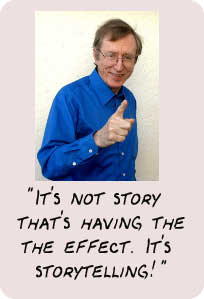|
|
Katalina Groh, Larry Prusak: Some of the world's leading thinkers |
| Storytelling to ignite change: Steve Denning |
 |
Storytelling,
not the story, has the impact
What are the limitations?
Well, we thought, if one story is good, , many stories must be even better.
So we recruited some people, and they put together twenty-five wonderful
stories, and we put them in a booklet, and put them in newsletters, and
as far as we could see, they had no absolutely no impact. No excitement.
No interest. No sign of any new activity. No discernible impact on the
organization at all.
|
| What we discovered
was of course was that there is huge divide between the things that are
visible and discernible in the organization i.e. the facts, the actions,
the policies, and the things are that are invisible and intangible, i.e.
the values, the attitudes, the narratives, the life narratives, We
spend most of our time in organizations talking and thinking about the
visible and discernible things, even though it is the invisible values
and attitudes and narratives that are actually driving most of what is
going on.
In effect, simply adding some more booklets and videos didnít get to realm of values and attitudes and narratives. The booklets and videos simply became part of the visible and discernible things in the organization. They became organizational artifacts. They were simply more of the stuff that is lying around a organization in huge quantities. They never entered the invisible realm of values and attitudes and narratives that are driving an organization. So in the written word, there is this disconnect between the speaker and the spoken, and you are not quite sure who is saying the words, and it tends to lack some authenticity. But if I am telling you a story, face to face, eyeball to eyeball, itís me and you, and something quite different is going on. And so we found that oral storytelling that in fact has the large impact, not putting stories into booklets and videos. This doesnít mean that you canít achieve big effects with books and videos, but they work in different kinds of ways. At the Smithsonian event in April 2001, weíll be showing some videos of real lives, told in a different kind of way. And of course, books like novels have always told stories in their own way, often very powerfully. So itís not that videos and books donít ever work. Itís just that they work in different kinds of ways from oral storytelling. |
| Books and videos on storytelling *** In Good Company : How Social Capital Makes Organizations Work by Don Cohen, Laurence Prusak (February 2001) Harvard Business School Press *** The Social Life of Information, by John Seely Brown, Paul Duguid (February 2000) Harvard Business School Press *** The Springboard : How Storytelling Ignites Action in Knowledge-Era Organizations by Stephen Denning (October 2000) Butterworth-Heinemann *** The Art of Possibility, a video with Ben and Ros Zander : Groh Publications (February 2001) |
| The views expressed on this website are those of Stephen Denning, and not necessarily those of any person or organization |
| Site optimized in 800x600: webmaster CR WEB CONSULTING |
|
|
|
|